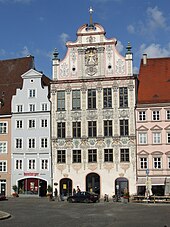Dominikus Zimmermann

Dominikus Zimmermann (born June 30, 1685 in Gaispoint , today Wessobrunn , † November 16, 1766 in Wies bei Steingaden ) was a Bavarian plasterer and master builder of the Rococo . He is considered one of the most important German rococo builders. Like his older brother Johann Baptist Zimmermann , with whom he often worked, he is assigned to the Wessobrunn School . Dominikus Zimmermann's main work, the Wieskirche , is a UNESCO World Heritage Site.
Life
Initially he worked as a plasterer, later as a master builder residing in Landsberg am Lech , where he acquired citizenship in 1716, was a member of the city council from 1734 and held the office of mayor from 1748 to 1753 .
On January 9, 1708 he married Theresia Zöpf and moved to Füssen for eight years. His son Franz Dominikus Zimmermann worked as a plasterer and builder.
His grave is in the cemetery of the collegiate church St. Johannes d. T. (Steingaden) .
style
Dominikus Zimmermann seems to have received his architectural training from Johann Jakob Herkomer in Füssen , but in Switzerland he also encountered the Vorarlberg building tradition , which he developed very freely. His design work as an architect is sometimes more shaped by decorative aspects than tectonic ones. In doing so, he succeeds in the unique synthesis of ornament and architecture : he implements the full repertoire of forms of an architect as a decorative artist. This synthesis particularly shapes the art of altar architecture , which he himself has decisively further developed. The design of the windows and interiors also aimed at staging the lighting conditions, an aspect of his architecture that was examined on film by the art historian Carl Lamb.
His church buildings (and their curved windows, for example) exerted a great influence , especially in Upper Swabia . Master builders like Jakob Emele and the Dossenberger deserve special mention here.
Honors
The Dominikus-Zimmermann-Realschule in Günzburg and the Dominikus-Zimmermann-Gymnasium in Landsberg am Lech were named after him. His portrait, painted by Erwin Henning, hangs in the conference room of the Landsberg town hall .
Major works
("+ JBZ" marks projects in which Johann Baptist Zimmermann was also involved)
- 1709–1741: Carthusian Church of St. Maria in Buxheim near Memmingen , Unterallgäu district , Baroque and redesign, fresco and plasterer (+ JBZ)
- 1716–1725: Maria Medingen monastery church in the district of Dillingen an der Donau (first work as master builder; + JBZ)
- around 1720: Monastery church of the Dominican convent Bad Wörishofen (stucco work; from 1721 also frescoes, + JBZ)
- u, 1720: stucco decorations in the dome and on the vault of the nave of the Würzburg Neumünster (as well as plaster inlay in Scagliola technique on the Boniface altar burned in 1945 in the northeast dome niche)
- 1719: Historic town hall in Landsberg am Lech
- 1726–1729: Sießen Monastery (+ JBZ)
- 1727: Parish church of St. Peter and Paul in Buxheim near Memmingen, Unterallgäu district
- 1728–1733: Steinhausen pilgrimage church near Bad Schussenried (+ JBZ; as the "most beautiful village church in the world" a main attraction on the Upper Swabian Baroque Route )
- 1735–1740: Frauenkirche in Günzburg
- 1738–1741: St. Anna , chapel of the Reich Charterhouse Buxheim near Memmingen, Unterallgäu district
- 1745–1754: pilgrimage church in the Wies near Steingaden (+ JBZ)
- 1752: Johanniskirche in Landsberg
- 1755–1756: Gutenzell monastery church
Individual evidence
- ↑ Henning, Erwin . In: Hans Vollmer (Hrsg.): General Lexicon of Fine Artists of the XX. Century. tape 2 : E-J . EA Seemann, Leipzig 1955, p. 420 .
- ↑ Stefan Kummer : Architecture and fine arts from the beginnings of the Renaissance to the end of the Baroque. In: Ulrich Wagner (Hrsg.): History of the city of Würzburg. 4 volumes; Volume 2: From the Peasants' War in 1525 to the transition to the Kingdom of Bavaria in 1814. Theiss, Stuttgart 2004, ISBN 3-8062-1477-8 , pp. 576–678 and 942–952, here: pp. 662 and 950.
literature
- Hermann Bauer , Anna Bauer: Johann Baptist and Dominikus Zimmermann. Origin and completion of the Bavarian Rococo . F. Pustet, Regensburg 1985, ISBN 3-7917-0918-6
- Paul Beck : Zimmermann, Dominikus . In: Allgemeine Deutsche Biographie (ADB). Volume 45, Duncker & Humblot, Leipzig 1900, pp. 254-256.
- Harriet Brinkmöller-Gandlau: Zimmermann, Dominikus. In: Biographisch-Bibliographisches Kirchenlexikon (BBKL). Volume 14, Bautz, Herzberg 1998, ISBN 3-88309-073-5 , Sp. 489-492.
- Leana Hearn, Markus Breitschmid , (Eds.): Church at Wies - Dominikus Zimmermann . Architecture History Case Studies Series, Volume 3, Corporis Publisher for Architecture, Art, and Photography, 2009, ISBN 978-0-9802274-3-7 (English)
- Hugo Schnell , Uta Schedler: Lexicon of Wessobrunn artists and craftsmen . Schnell and Steiner, Munich and Zurich 1988, ISBN 3-7954-0222-0 , pp. 325–339 (detailed list of works)
Web links
- Literature by and about Dominikus Zimmermann in the catalog of the German National Library
- Dominikus Zimmermann. In: arch INFORM .
| personal data | |
|---|---|
| SURNAME | Carpenter, Dominic |
| BRIEF DESCRIPTION | German plasterer and builder of the Rococo |
| DATE OF BIRTH | June 30, 1685 |
| PLACE OF BIRTH | Gaispoint near Wessobrunn |
| DATE OF DEATH | November 16, 1766 |
| Place of death | Wies bei Steingaden |


